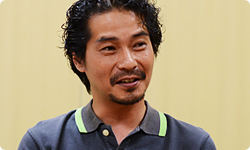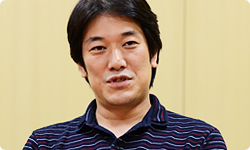I’d like to ask about the game’s content. How did those distinctive characters and that vast ocean world come to be?
Without much hesitation, we decided rather early on to set the game among the seas. We liked how we could use the open sea in designing the mechanics of the game world, and more than anything, we thought it would be interesting to show the sea in that visual style. I think we got into a good flow with everyone coming up with ideas about what the islands in those seas should be like and what the people living there would be like.
Even for a game in the Zelda series, quite a lot of distinctive characters that we haven’t seen before show up in The Wind Waker.
I remember that the planning staff and the character production team, led by Haruhana-san, played off each other really well.

Ever since Ocarina of Time, Haruhana-san had been proposing a lot of eccentric characters, but for The Wind Waker, it was like he had powered up! (laughs)
It seems like the whole world of The Wind Waker was created by boiling down those eccentric essences.
That’s the strength of that visual style. With the stylised, anime-like look, no matter how big the head was, or how short the legs were, it didn’t feel weird. Rather, it all gave a positive impression where everyone was just fine with it.
Yes. The characters are truly rich and expressive.
Right, their expressiveness really leaves a lasting impression. When you try to make the expressions realistic, it usually comes off as awkward because of the differences with real life. But with those visuals, those things don’t become an issue and you can express all kinds of facial expressions and gestures.
That’s right. Until Ocarina of Time, if we wanted to make a single mouth movement, for example, it was difficult to express some things, so we put a lot of effort into that in The Wind Waker.
Now that the eyes had gotten much larger, we wanted to make their facial expressions richer by increasing the number of patterns for the eyes and mouth. Partway through, we even talked about having beams come out of those eyes! (laughs)
Really? Eye-beams?!
(Shigeru) Miyamoto-san and (Takashi) Tezuka-san18 said we needed to supply a reason for the eyes being so big. I don’t think beams were really an option, though.18. Takashi Tezuka: General Manager, Software Development Department, Entertainment Analysis & Development Division. He has been involved in the development of many series such as Super Mario, Yoshi and Animal Crossing. He has appeared in sessions of “Iwata Asks” over the Iwata Asks: New Super Luigi U, the original Super Mario developers for the 25th anniversary of Super Mario, the history of handheld Legend of Zelda games for The Legend of Zelda: Spirit Tracks, New Super Mario Bros. Wii (Volume 2), and the producers of Super Mario 3D Land, as well as in the special edition sessions of "Iwata Asks" for E3 2012 covering New Super Mario Bros. U and New Super Mario Bros. 2.
We made it so when you stop, the eyes move, looking this way and that way .
Right, right! That’s when we had the idea of Link’s gaze providing a hint. We used that later in Ocarina of Time 3D, but the first time we’ve done it was The Wind Waker.
Oh, so that’s how that happened.
Until then, in Zelda games, we had kept some things back so that the players would play as if they were Link himself. But in The Wind Waker, even though you control Link, you also view him objectively and play as if you were interacting with the world through Link. The manner of emotional investment is a little different than in previous Zelda games, and as you spend time with it, it gradually grows on you.
It’s like that advertising line we used at the time (in the Japanese market) about it being animation you can touch. After development began, was it like you shot straight to the end without any hesitation?
We never hesitated in our desire to make a completely new Zelda game. But we did notice the negative reaction when we announced it, so we were uneasy. But developing the game timidly would have been the worst thing, so we plunged ahead, determined to go all-out hoping to gain acceptance.
What was it like watching development from the outside, Iwamoto-san?
I wasn’t watching too much, but when I actually bought the game and played it, I was surprised at how vivid the animation was. But aside from the visuals, a few things did bother me.
He did deliver some pretty tough opinions. But since he pays so much attention, we asked him to be director this time.
To expand upon that, there was talk at the time of how the early parts of the game were perfect but later on it sort of dragged. Of course, a lot of people said it felt great to be in that world, so they enjoyed playing to the end, but I think those words express a representative evaluation from players of The Wind Waker.
My viewpoint was entirely that of a player, and as I played, I noticed places that made me think, “Ah, that’s not quite right…” and “If they had just done this, it would’ve been better!” And this time, I played through the game again, and I noticed places that should be changed to update it for the players today.

Yes, the times have changed.
Yes. So I listed up those points, listened to opinions from the staff members who had made it, and in the end, determined areas in need of adjustment.
If you fix it like that, it gets dramatically better – so much so that you think, “Why didn’t we do it that way in the first place?”
Miyamoto-san often says that if you make a game twice, it gets better. Which is something to reflect upon. But I always say, “Yeah, but usually you can’t do that!” (laughs)
That’s so true.
Even if you don’t make it twice, when you’re about to rush toward the finish line, if you have a few moments to look back, you may notice some things.
I know… You’re absolutely right, but when you’re in a mad dash, looking back is impossible.
I can understand that, too! (laughs)
I’m sure you did your best at the time, and I do think the staff, in their enthusiasm, poured a huge amount of energy and ideas into it. If they hadn’t, we wouldn’t have done an HD remake.
And we can only see some things now because eleven years have passed.
Chances to look back with a cool head and make a game all over again like what we’re doing now are rare.
(nods in agreement)
But this time, you got to!
That criticism about the first half being perfect and the latter half too tough has always hurt, so I think if it was just five years ago, I wouldn’t have had the willpower to do this.
© 2024 Nintendo.